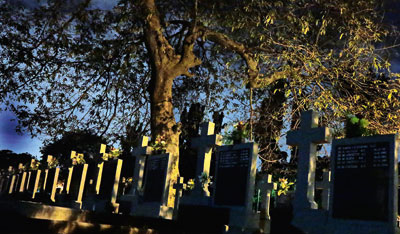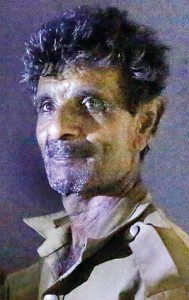Amidst the departed in the dead of night

Eerie images which play tricks on the mind at Kanatte. Pix by M.A. Pushpa Kumara
Kanatte re-visited at midnight!
Deadly silence is what greets us, even though several hours before many men, women and children have gathered at the graves of loved ones to shed a tear, whisper a prayer, place a few flowers and get back to their routines, as one necessarily must.
It is midnight on All Souls’ Day, November 2, and the Christian burial section including the Roman Catholic (RC) area has been busy with people walking to and fro, and a mass in the late evening adjoining the RC chapel tolling the end to the day set aside for the honouring of the dead.
There is a hint of rain and heaviness in the air as lightning streaks the dark, cloudy sky and we walk in through the main gate of Kanatte, having assured the night watchman, P.V.K. Ananda, 55, that we have got the necessary approvals. He opens the huge padlock dividing the world of the living from the dead to let us in. His two faithful dogs, of questionable origin, sniff around our ankles and get back to the buth packet that has been unwrapped for them by their master.
We do not take the dimly-lit straight and middle path which seems to divide the Land of the Dead, bordering Baseline Road at Borella into two but cut across to the far edge on the right, being swallowed up by the gloom.
As I am assailed by fears of treading on a creature of the night, a poisonous polonga (Russell’s viper) or cobra, with images of the serpent which tempted Eve to take a bite of the Forbidden Fruit rushing through my mind, far, far away in a very corner of the RC section there appears a red glow.
In a few seconds it is gone, only to reappear again……..and we tread in silence towards the grave from which it emanates, literally lying buried in the darkness, jumping out of our skin as a large bat silently hovers over us and wings its way to a different corner of Kanatte, most probably in search of its dinner.
Strangely, the glow is from a tiny candle on a grave, lit during the prayers for all souls, with its flame flickering bravely this way and that into the wee hours of the next morning, against all probability, in the breeze laden with moisture.
We move on passing huge mara and kumbuk trees spreading their canopies like silent sentinels guarding the departed and Ananda whose workplace has been Kanatte in the past 36 years, regales us with tales of what he has “felt” and what his colleagues have seen. The dogs have dared not accompany us but their persistent yowling (uda buranawa) follows us everywhere we go.
“Yes, the dogs see what we may not be seeing,” says Ananda, recalling how once not so long ago he was on the verge of deep sleep, seated on the bench near the small office at the Kanatte entrance, looking out onto Baseline Road, when he felt someone feeling him thoroughly all over his body. “Mulu agama athagava,” he says.

Ananda: Full of tales
Jerking awake, he had found himself looking at a very tall man, no not a foreigner, but “thalelu” (olive-skinned) like us. And behind him stood a row of “little fellows” having the “ekama cut eka”. The moment, Ananda was wide-awake though, the tall man and his small progeny vanished into thin air.
A more recent incident is related with gusto by Ananda. About seven months ago, a knot of young fellows had been walking along the path towards the main gate, joking and playing the fool as the young are wont to do. It was that time between dusk and night, around 7 p.m., when the evening shadows begin to lengthen.
Having been to a funeral, selfies were the order of the evening and the young men had stopped near the RC chapel to take one, when to their consternation what appeared on the mobile screen with their own grinning faces sent chills down their spines – posing with them was a woman in her thirties, clad in white, with her long hair let loose.
“In the photo was a weeping and dancing woman,” says Ananda, vowing that his colleagues saw the photo. The young fellows had run out of the gate and he believes that they may not return to Kanatte for a long time. Now as we pass that area, the only remnants are the pristine white marquees starkly silhouetted against the pitch-black night, put up for the RC faithful who have come a-visiting their loved ones. The food packets that they have distributed as alms among the beggars who have had their fill, litter the area with rotting food and sili-sili bags.
By now we have arrived at the decrepit hall where the Buddhists keep the dear-departed to bestow paansakula, before cremation, and seated on the structure where the coffins would be kept, while staring out into the darkness, making the imagination run wild, Ananda tells us how, when weary labourers lie on this very same slab to have 40-winks even during the day, they would be violently pushed off by an unseen hand.
Off we go again, our footfalls amidst the leaves on the pathways sounding as if someone is to the rear of us, making us look over our shoulders frequently and in the distance as if numerous beings are watching our progress. Relieved we are, as we get close and see that they are tombstones taking human shapes by the play of light and shadow.
Yes, Ananda and his fellow keepers, when spending their long vigil seated on the floor of the crematorium have not only heard footsteps and shrieks but also the doors where the coffin is pushed through banging and people knocking on them. But on that midnight of All Souls Day, there is only silence broken by the cicadas in competition with the deep-throated croaks of frogs heralding the rain.
The cemetery tour goes on with Ananda urging us to take photographs with our mobile phones, quite sure that the spirits moving in the dead of night get “caught” on them even though we cannot see them.
The days when spirits roam Kanatte most, according to Ananda, are Tuesdays and Fridays and those are the days when suddenly his doggies would come whining towards him as if they want to lead him where they can spot the chayava (image).
Talkative Ananda tells us how a politician’s son arrived in a big cab (double-cab) maha re (in the dead of night) to conduct research, swished down a quarter of arrack and strode around Kanatte. “Photo gahala, video karala,” he and a few others had finally stopped at the tomb of a famous singer and then “yanna giya”.
He then launches into tales of smaller fry, most probably kudu karayas (drug addicts) who come as tomb raiders to rip off the gold tinting on the frames of photos mainly of dead Roman Catholics whose relatives have made good in Italy as also the nickel-plated fences demarcating the graves.
We are also given an insight into the different rituals performed at Kanatte. The Hindus usually place porri and some coins in the coffin and just before cremation a kale (clay-pot) is shattered into smithereens. The next morning, the relatives come, bearing idli, string-hoppers, vadai, curd and treacle and coconut which they will throw to the crows. They will also share the excess food with the workers.
Onto a beautifully manicured enclosure we come, and Ananda says it is the burial ground of the Japanese. On and off, many Japanese would arrive here, set up a large table and leave luscious fruit such as papaya, pineapple, apples and grapes for their dear-departed.
Did you know, he asks, that if the coffin of a Buddhist is too big, an egg will be placed in a corner?
As we near the main entrance having sojourned in the Land of the Dead, nothing has changed, but the dogs begin to whine and cringe at Ananda’s feet as he asks, “Ai Putha?”
Kavuruhari lagin giyama thama kendiri ganne, he says, adding with mustered-up conviction, “Baya ne, evunata hitha gessenawa.” (It is when someone passes-by that the dogs whine. I’m not scared, but the mind gets a bit shaken)
For us it is an uneventful tour of Kanatte – during the last visit in September 2013, the time on my mobile changed while I was in there, making me wonder whether there are different time zones for the dead and the living. (See ‘Who goes there?’ in the PLUS of September 29, 2013.)
This time, however, there is no such change – maybe the world of the dead has not yet caught up with the advancements in technology. For now I have a smart phone!


